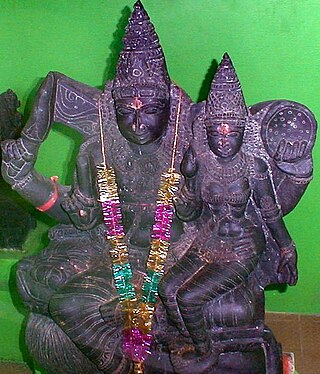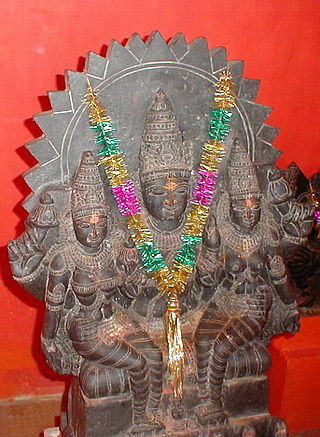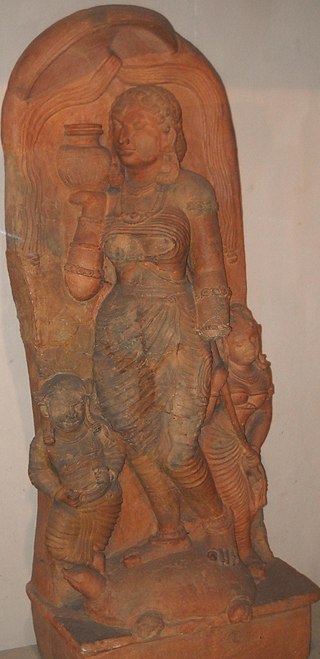
Matsya is the fish avatar of the Hindu god Vishnu. Often described as the first of Vishnu's ten primary avatars, Matsya is described to have rescued the first man, Manu, from a great deluge. Matsya may be depicted as a giant fish, often golden in color, or anthropomorphically with the torso of Vishnu connected to the rear half of a fish.

Avatar is a concept within Hinduism that in Sanskrit literally means 'descent'. It signifies the material appearance or incarnation of a powerful deity, or spirit on Earth. The relative verb to "alight, to make one's appearance" is sometimes used to refer to any guru or revered human being.

Puranas are a vast genre of Hindu literature about a wide range of topics, particularly about legends and other traditional lore. The Puranas are known for the intricate layers of symbolism depicted within their stories. Composed originally in Sanskrit and in other Indian languages, several of these texts are named after major Hindu gods such as Vishnu, Shiva, Brahma, and Mahadevi. The Puranic genre of literature is found in both Hinduism and Jainism.
In Hinduism, Itihasa-Purana, also called the fifth Veda, refers to the traditional accounts of cosmogeny, myths, royal genealogies of the lunar dynasty and solar dynasty, and legendary past events, as narrated in the Itihasa and the Puranas. They are highly influential in Indian culture, and many classical Indian poets derive the plots of their poetry and drama from the Itihasa. The Epic-Puranic chronology derived from the Itihasa-Puranais an influential frame of reference in traditional Indian thought.
Manu is a term found with various meanings in Hinduism. In early texts, it refers to the archetypal man, or the first man. The Sanskrit term for 'human', मनुष्य or मानव means 'of Manu' or 'children of Manu'. In later texts, Manu is the title or name of fourteen rulers of earth, or alternatively as the head of dynasties that begin with each cyclic kalpa (aeon) when the universe is born anew. The title of the text Manusmriti uses this term as a prefix, but refers to the first Manu – Svayambhuva, the spiritual son of Brahma. In the Hindu cosmology, each kalpa consists of fourteen Manvantaras, and each Manvantara is headed by a different Manu. The current universe, is asserted to be ruled by the 7th Manu named Vaivasvata. Vaivasvata was the king of Dravida before the great flood. He was warned of the flood by the Matsya (fish) avatar of Vishnu, and built a boat that carried the Vedas, Manu's family and the seven sages to safety, helped by Matsya. The tale is repeated with variations in other texts, including the Mahabharata and a few other Puranas. It is similar to other floods such as those associated with Gilgamesh and Noah.

Sanjna, also known as Saranyu, is a Hindu goddess associated with clouds and the chief consort of Surya, the Sun god. She is mentioned in the Rigveda, the Harivamsa and the Puranas.

The Sanskrit text Garuda Purana is one of 18 Mahapuranas in Hinduism. The Garuda Purana was likely composed in the first millennium CE, with significant expansions and revisions occurring over several centuries. Scholars estimate that the earliest core might date back to between the 4th and 11th centuries CE, with substantial additions and modifications continuing into the 2nd millennium CE.
The Viṣṇu Purāṇa is one of the eighteen Mahapuranas, a genre of ancient and medieval texts of Hinduism. It is an important Pancharatra text in the Vaishnavism literature corpus.
Svayambhu is a Sanskrit word that means "self-born", "self-manifested", "self-existing", or "that that is created by its own accord". Various deities and entities featured in Hindu literature and tradition are regarded to be svayambhu, such as Brahman in the Upanishads, and the Trimurti of Brahma, Vishnu, and Shiva, and Manu in the Puranas.

Yama, also known as Kāla and Dharmarāja, is the Hindu god of death and justice, responsible for the dispensation of law and punishment of sinners in his abode, Naraka. He is often identified with Dharmadeva, the personification of Dharma, though the two deities have different origins and myths.
Chakshusha Manu is the sixth Manu, the first man of an age known as the Manvantara in Hindu mythology.

Prithu, also called Pruthu, Prithi and Prithu Vainya, is a sovereign (chakravarti) in Hinduism. He is an avatar of the god Vishnu.

Vaivasvata Manu, also referred to as Shraddhadeva and Satyavrata, is the current Manu—the progenitor of the human race. He is the seventh of the 14 Manus of the current kalpa (aeon) of Hindu cosmology. In Jainism he is known as Nabhiraaj who is father of first jain teerthankar Aadinath's father and the last kulkar of Jainism.
A manvantara, in Hindu cosmology, is a cyclic period of time identifying the duration, reign, or age of a Manu, the progenitor of mankind. In each manvantara, seven Rishis, certain deities, an Indra, a Manu, and kings are created and perish. Each manvantara is distinguished by the Manu who rules/reigns over it, of which we are currently in the seventh manvantara of fourteen, which is ruled by Vaivasvata Manu.

The Dashavatara are the ten primary avatars of Vishnu, a principal Hindu god. Vishnu is said to descend in the form of an avatar to restore cosmic order. The word Dashavatara derives from daśa, meaning "ten", and avatāra, roughly equivalent to "incarnation".

Vishnu, also known as Narayana and Hari, is one of the principal deities of Hinduism. He is the supreme being within Vaishnavism, one of the major traditions within contemporary Hinduism.

Ila or Ilā is a deity in Hindu legends, known for their sex changes. As a man, he is known as Ila or Sudyumna and as a woman, is called Ilā. Ilā is considered the chief progenitor of the Lunar dynasty of Indian kings – also known as the Aillas.

Chhaya or Chaya, also known as Savarna, is the Hindu personification and goddess of shadow, and a consort of Surya, the Hindu sun god. She is the shadow-image or reflection of Saranyu (Sanjna), the first wife of Surya. Chhaya was born from the shadow of Sanjna and replaced Sanjna in her house, after the latter temporarily left her husband.

Yamuna is a sacred river in Hinduism and the main tributary of the Ganges River. The river is also worshipped as a Hindu goddess called Yamuna. Yamuna is known as Yami in early texts, while in later literature, she is called Kalindi. In Hindu scriptures, she is the daughter of Surya, the sun god, and Sanjna, the cloud goddess. She is also the twin sister of Yama, god of death. She is associated with the deity Krishna as one of his eight principal consorts, called the Ashtabharya. Yamuna plays an important role in Krishna's early life as a river. According to Hindu scriptures, bathing in or drinking Yamuna's waters removes sin.
A Yuga Cycle is a cyclic age (epoch) in Hindu cosmology. Each cycle lasts for 4,320,000 years and repeats four yugas : Krita (Satya) Yuga, Treta Yuga, Dvapara Yuga, and Kali Yuga.











